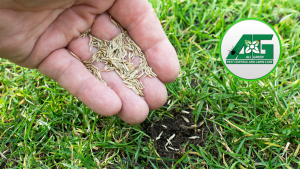
Pre-Emergent vs. Seeding: Timing Is Everything for a Beautiful Lawn
As winter fades and warmer days arrive, homeowners across the country feel the pull to get outside and give their lawns some TLC. Spring is when everyone seems to develop a green thumb—eager to fertilize, water, and especially seed those patchy, winter-worn spots. But there’s a crucial decision to make early in the season: Do you seed your lawn or apply a pre-emergent herbicide? Because when it comes to these two lawn care strategies, you can’t do both at the same time.
Let’s break down when to apply pre-emergent, when to hold off, and how to time your spring lawn care for the best results.
What Is Pre-Emergent and Why Use It?
Pre-emergent herbicides are designed to prevent weed seeds—like crabgrass and other annual nuisances—from germinating and growing. These herbicides create a barrier in the soil that stops young weed seedlings before they ever have a chance to break through the surface.
It’s one of the most effective ways to control spring and summer weeds before they become a problem. But that same barrier also affects grass seed. If you plan to overseed, reseed, or start a brand new lawn, applying pre-emergent will also prevent your grass seed from growing.
➡️ Learn more: University of California IPM – Pre-emergent Herbicides
Why Spring Seeding Sounds Tempting
After a long winter, it’s common to see bare patches, thinning turf, or areas damaged by snow mold or salt. That’s why many homeowners turn to seeding in the spring—it seems like the quickest way to get a fuller, greener lawn. And if you’re not battling weeds, that might be a good move!
But seeding in the spring comes with its own set of challenges, especially because grass seedlings are often less established by the time summer heat kicks in. Plus, you’re leaving your lawn exposed to all the weeds that would’ve been stopped by pre-emergent.
➡️ Learn more: Penn State Extension – Establishing a Lawn
The Golden Rule: Don’t Seed and Use Pre-Emergent at the Same Time
Here’s the simple truth:
If you plan to seed your lawn in the spring, you must skip the pre-emergent.
If you plan to apply pre-emergent, you must wait to seed.
That’s because pre-emergents don’t discriminate—they stop any seed from growing, including your new grass seed.
➡️ Learn more: Purdue University – Turfgrass Weed Control for Professionals (PDF)
How Long Does Pre-Emergent Last?
Most pre-emergents remain active in the soil for 8 to 12 weeks, depending on the product and environmental conditions. During that time, any seed (weed or grass) trying to germinate will fail.
If you choose to apply a pre-emergent in early spring (typically when soil temps reach about 55°F), you’ll need to wait until late summer or early fall to seed your lawn. That’s usually the ideal time for cool-season grasses anyway, as temperatures are milder and weeds are less aggressive.
➡️ Learn more: University of Illinois Extension – Lawn Care Calendar
The Importance of Keeping New Seed Moist
If you decide to seed your lawn—whether you’re patching, overseeding, or starting from scratch—consistent moisture is critical for success. Grass seed needs to remain moist (not soaked, not dry) during the entire germination period, which typically lasts 2 to 3 weeks, depending on the grass type and weather conditions.
Why is this so important?
When grass seed dries out after it’s started to germinate, it dies. There’s no pause or restart button—just dead seed. Moisture is what triggers the seed to begin sprouting, and it must stay consistently damp so it can push roots into the soil and shoot blades upward.
Watering Tips for Germinating Grass Seed:
- Water 2–4 times per day in short, light bursts (5–10 minutes each) to keep the top inch of soil consistently damp.
- Use a fine mist or gentle spray to avoid washing away seed or creating puddles.
- As seedlings mature (after 2–3 weeks), begin reducing frequency and increasing watering depth to encourage deeper root growth.
➡️ Learn more: University of Minnesota – Watering New Lawns
Proper watering during germination is one of the most overlooked steps in lawn success. Many homeowners plant seed and hope for rain—but daily commitment to light watering can make all the difference between a lush lawn and patchy failure.
Pros and Cons: Seeding vs. Pre-Emergent in the Spring
Option 1: Apply Pre-Emergent (and Skip Spring Seeding)
Pros:
- Effective weed prevention (especially crabgrass and other annuals)
- Cleaner, more uniform lawn appearance in summer
- Less competition for your existing grass
Cons:
- Can’t seed until late summer or fall
- Thin or bare spots remain visible through spring and early summer
- New lawns or major repairs must wait
Option 2: Seed (and Skip Pre-Emergent)
Pros:
- You can fill in patchy areas or establish a new lawn
- Promotes thicker grass coverage (long-term weed prevention)
- Great for lawns needing repair or recovery
Cons:
- Weed pressure is higher without pre-emergent
- Requires a lot of attention (frequent watering)
- Young grass may struggle in hot summer weather
➡️ Learn more: North Carolina State – Overseeding Lawns
What Should You Do?
The right choice depends on your lawn’s condition and priorities:
- If you have a mostly healthy lawn with just a few bare spots, applying pre-emergent may be the smarter call. You can always seed in the fall, which is often the best time to establish new grass.
- If your lawn is thin, patchy, or struggling, and you need to seed now, it’s okay to skip the pre-emergent—just be ready to deal with weeds and plan for post-seeding care to keep them at bay.
➡️ Learn more: University of Maryland – Lawn Establishment and Renovation
Timing Is Everything
If you seed this spring, you’ll need to wait at least 8–12 weeks after applying pre-emergent before adding any new grass seed. In most cases, that means waiting until late summer or fall.
If you apply seed too soon after a pre-emergent application, you’re simply wasting your time (and money)—because those grass seeds won’t stand a chance.
Final Thoughts
Spring lawn care is all about making strategic choices. While it’s tempting to do everything at once—seed, fertilize, water, and fight weeds—you need to choose between pre-emergent or seeding. Both are great tools, but only when used at the right time.
If you seed, commit to watering. If you pre-emerge, commit to postponing seeding. Either way, your lawn will thank you.
Our technicians know when it’s best to apply pre-emergent or if it’s better to re-seed in the spring. Learn more about the benefits of each here!
